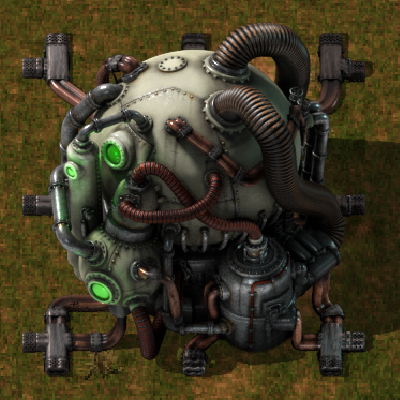Nuclear reactor
| Nuclear reactor |
|
Recipe |
|
| + + + + → | |
|
Total raw |
|
| + + + + + |
|
Recipe |
|
| + + + + → | |
|
Total raw |
|
| + + + + + |
|
Map color |
|
|
Health |
500 |
|
Stack size |
10 |
|
Dimensions |
5×5 |
|
Energy consumption |
40 MW (burner) |
|
Maximum temperature |
1000 °C |
|
Mining time |
0.5 |
|
Prototype type |
|
|
Internal name |
nuclear-reactor |
|
Required technologies |
|
|
Produced by |
|
|
Valid fuel |
|
The nuclear reactor generates heat by burning uranium fuel cells. The heat can be used in a heat exchanger to produce steam which can be used to generate power. Unlike other forms of power generation, it is load-independent – each fuel cell will always be used completely in 200 seconds, regardless of load or the temperature of the reactor. To prevent wasting fuel, excess power can be stored in accumulators, excess steam can be stored in storage tanks.
Instead of completely consuming the fuel, burning fuel in a nuclear reactor results in used up uranium fuel cells. These used up cells can be reprocessed in a centrifuge to get back some of the uranium used to create the fuel cells.
Nuclear reactors have a heat capacity of 10 MJ/C. Thus, they can buffer 5 GJ of heat energy across their working range of 500°C to 1000°C, and require 4.85 GJ of energy to warm up from 15°C to 500°C when initially placed.
Neighbour bonus
Reactors receive a bonus for adjacent operating reactors, which increases their effective thermal output by 100% per each such link. For example, two reactors operating next to each other will output a total of 160 MW of thermal energy, with each reactor producing 40 MW base and receiving 40 MW of neighbour bonus.
The Neighbour bonus only applies if:
- 2 reactors are directly next to eachother with all 3 heat connections directly connecting the two.
- Both reactors are fueled.
Double-row layout
The most efficient practical layout is an aligned double row of arbitrary length (number of reactors as needed). For even numbers of reactors, the total output of the array is 160n − 160 MW (where n = total number of reactors, and assuming all are fueled). Splitting the row, while possibly logistically beneficial, reduces total power output by 160 MW per split.
Odd numbers of reactors are inefficient in maximizing the bonus, but, if needed, the odd reactor should be aligned with one of the rows. Offsetting the longer row instead would not gain the extra reactor any bonus, while the reactor on the other end of the same row would lose its bonus as well. Placing the odd reactor between the ends of aligned rows would also lead to one fewer bonus, and also make the design un-tileable.
In any case however, such concerns are unlikely to arise until one has a very large base, as the individual output of reactors is massive, particularly with neighbour bonuses. As an example, a 5×2 reactor grid would produce 1,440 MW (1.44 GW), the equivalent of 1,600 steam engines, or 24,000 solar panels.
Square layout
Theoretically, a perfectly square grid of reactors with no spaces between would provide maximum bonus, as it minimizes the number of reactors with unlinked sides. This setup produces 200n − 160×sqrt(n) MW (where sqrt(n) is the square root of the number of reactors).
However, while the heat pipe links will allow energy flow from reactors within the square, with no room around inner reactors, there will be no way to insert and remove fuel cells except manually (heat pipes are traversable by the player), which makes this setup impractical.
Furthermore, the gains compared to the double-row design are not large. After some calculation, one arrives at the expression for the ratio of the two (double-row design in denominator) as (1.25n − sqrt(n)) ÷ (n − 1) which evaluates to, for example, 1 for 4 reactors, 1.07 for 16 reactors, 1.16 for 100 reactors (considering only numbers that both an equal-length double row and a square can be built from), and so on. In the limit (infinite number of reactors), the ratio approaches 1.25 as the edge corrections become insignificant.
Explosion
If a reactor is destroyed (by damage) while it is above 900°C, it will explode just like an atomic bomb. This explosion has enough power to destroy other reactors, so one explosion can lead to a chain reaction of exploding reactors. [1]
History
- 0.18.0:
- Updated sound effects.
- 0.17.67:
- Heat pipes (also in reactors and heat exchangers) glow with high temperatures.
- 0.16.0:
- Changed nuclear reactor stack size to 10.
- 0.15.0:
- Introduced
